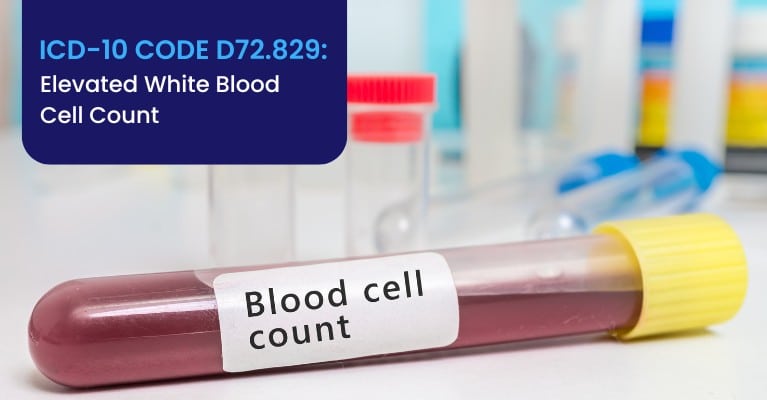

ICD-10 Code D72.829 is essential in medical coding for documenting elevated white blood cell count, unspecified. This code is used across healthcare settings to indicate an unspecified elevated white blood cell count. With the knowledge to apply this code effectively, ensuring compliance with health regulations and optimizing patient outcomes. The blog provides a detailed guide to D72.829 practical usage, common errors, and tips for best practices in medical billing and coding.
The D72.829 diagnosis code represents an unspecified elevation in white blood cell count, commonly used in medical coding to document conditions without specifying the type of leukocyte that is elevated. It covers a broad range of possible conditions that result in an increased total white blood cell count without further specification. An unspecified elevated WBC count, as captured by D72.829, can indicate a variety of underlying conditions including infections, inflammation, stress responses, and other medical issues.
Understanding the nuances of this diagnosis code is crucial for healthcare providers, medical coders, and billing specialists to ensure accurate diagnosis, effective treatment planning, and precise medical billing.
| Aspect | Details |
| ICD-10 Code | D72.829 |
| Description | Elevated white blood cell count, unspecified |
| D72 | This part of the code indicates disorders related to white blood cells. |
| .829 | This specific subcode signifies an unspecified elevation of white blood cells. |
| Category | Other disorders of white blood cells |
| Common Conditions | Infections, inflammation, stress, medications, underlying medical conditions |
| Clinical Relevance | Identifies potential infections, monitors disease progression, ensures compliance with regulations |
The presence of an elevated white blood cell count, unspecified as per D72.829, often prompts additional testing and diagnostic procedures. White blood cells play a critical role in the immune response, and their elevated levels can signal that the body is fighting an infection or other inflammatory process. In clinical practice, this diagnosis code helps guide initial treatment decisions while further investigations are carried out.
These diagnostic tests and procedures are essential for accurately identifying the underlying cause of an unspecified elevated WBC, aiding in effective treatment planning and compliance with medical billing and coding guidelines.
| Diagnostic Test | Description |
| Complete Blood Count (CBC) with Differential | Measures the total number of white blood cells and provides a breakdown of different types of WBCs |
| Peripheral Blood Smear | Examines the appearance of blood cells under a microscope |
| Bone Marrow Biopsy | Extracts a sample of bone marrow for examination |
| Flow Cytometry | Analyzes the physical and chemical characteristics of cells in a fluid sample |
| Molecular and Genetic Tests | Detects genetic mutations and abnormalities |
| Imaging Studies | Provides visual assessment of internal organs (e.g., X-rays, CT scans, MRIs) |
| Infectious Disease Tests | Detects specific infections (e.g., blood cultures, viral and bacterial tests) |
| Autoimmune Panels | Assesses for autoimmune conditions (e.g., ANA, RF tests) |
| Serum Protein Electrophoresis (SPEP) | Evaluates the levels of different proteins in the blood. |
By maintaining comprehensive and detailed documentation, healthcare providers can ensure accurate coding and billing for ICD-10 Code D72.829, leading to better patient outcomes and streamlined revenue cycle management.
| Documentation Aspect | Details |
| Patient Symptoms | Record all relevant symptoms indicating elevated white blood cell count (unspecified). |
| Diagnostic Tests | Include results from blood tests and other diagnostics that support the D72.829 diagnosis. |
| Treatment Plans | Document treatments provided, responses, and any changes in the treatment plan. |
| Progress Notes | Regular updates on patient condition and treatment effectiveness. |
Proper use of ICD-10 Code D72.829 for unspecified elevated white blood cell count is crucial not only for patient care but also for ensuring compliance with health regulations, accurate medical billing, and adherence to coding guidelines.
Chief Complaint: Routine check-up; reports slight fatigue over the past few weeks.
Clinical Findings: Complete Blood Count (CBC) shows an elevated white blood cell count of 12,000 cells/mcL. Differential count does not indicate a significant increase in any particular type of white blood cell.
Diagnosis: ICD-10 Code D72.829 – Elevated white blood cell count, unspecified
Plan: Recommend further evaluation to determine the underlying cause. Consider follow-up tests, including a peripheral blood smear and a repeat CBC in one month.
Progress Notes: Patient informed of results and the need for further evaluation. Follow-up appointment scheduled for one month.
Billing: Primary Diagnosis Code: D72.829 and Procedure Codes: CPT 85025 (CBC with Differential).
Accurately applying ICD-10 Code D72.829 is essential for documenting unspecified elevated white blood cell counts. Proper usage ensures compliance with health regulations, supports precise medical billing, and enhances patient care. By maintaining comprehensive documentation, employing updated coding practices, and engaging in continuous education, healthcare providers can optimize diagnosis and treatment planning. These practices contribute to improved patient outcomes and streamlined revenue cycle management.
It is used to document an unspecified elevated white blood cell count. This code is crucial in medical coding to indicate that the elevation in white blood cells does not specify the type of leukocyte that is elevated.
Elevated white blood cell counts can result from various underlying conditions, including infections, inflammation, stress responses, medications, and other medical issues such as bone tumors or parasitic infections.
Accurate documentation is essential for supporting the medical necessity of the diagnosis, ensuring precise billing and reimbursement, and complying with healthcare regulations. It involves recording patient symptoms, diagnostic test results, treatment plans, and progress notes.
Additional tests include:
Proper use of D72.829 ICD-10 Code ensures that healthcare providers can accurately bill for diagnostic processes and receive appropriate reimbursement. It is important for avoiding claim rejections and ensuring compliance with insurance requirements. Correctly documenting and coding this diagnosis supports smooth billing processes and helps avoid financial discrepancies



